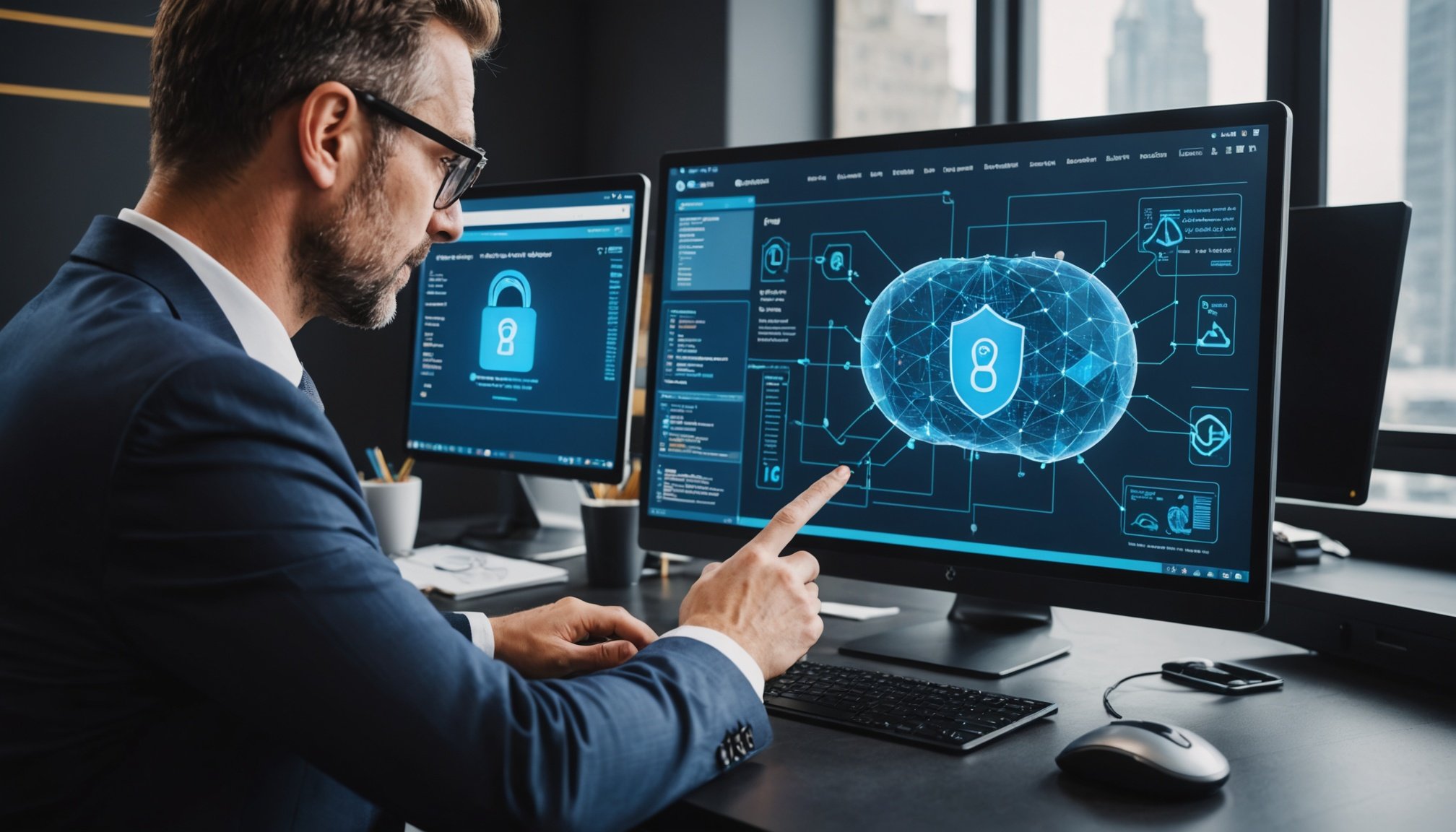Crafting an Unshakeable Cybersecurity Blueprint for Fintech: Key Strategies for Ultimate Protection
In the rapidly evolving landscape of financial technology (fintech), cybersecurity is no longer just a necessity, but a cornerstone of trust and success. As fintech companies handle vast amounts of sensitive financial data, they become prime targets for cybercriminals. Here’s a comprehensive guide on how to craft an unshakeable cybersecurity blueprint, ensuring the ultimate protection of your fintech operations.
Understanding the Regulatory Landscape and Compliance
Before diving into the technical aspects of cybersecurity, it’s crucial to understand the regulatory landscape that governs the fintech industry. Compliance with regulations such as the General Data Protection Regulation (GDPR), the Payment Card Industry Data Security Standard (PCI DSS), and other local and international standards is paramount.
Have you seen this : Leveraging AI to Strengthen Critical Infrastructure: Building Resilient Networks for Unparalleled Success
Key Regulatory Requirements
- GDPR: Ensures the protection of personal data of EU citizens, mandating strict data handling and privacy practices[2][3].
- PCI DSS: Specifically designed for the payment card industry, it sets standards for securing cardholder data[2].
- Local Regulations: Various countries have their own set of regulations, such as the California Consumer Privacy Act (CCPA) in the United States.
Implementing Compliance
To ensure compliance, fintech companies must implement strong internal controls. This includes:
- Clear Protocols: Define roles, responsibilities, and procedures to limit exposure to potential risks.
- Automated Systems: Use technology to track transactions, monitor anomalies, and produce reports seamlessly[3].
- Regular Audits: Conduct regular security audits and penetration testing to identify and address vulnerabilities.
Prioritizing Cybersecurity Measures
Cybersecurity is the backbone of any fintech operation. Here are some key strategies to prioritize cybersecurity:
Also to discover : Revolutionary AI Innovations: Enhancing User Experience in Smart Home Automation
Implementing Robust Encryption Practices
Encryption is a critical strategy for safeguarding sensitive data. Here’s how it works:
- Data Encryption: Use strong encryption protocols like AES and RSA to protect data both at rest and in transit[2].
- Password Security: Employ secure algorithms to hash passwords and other sensitive identifiers.
- Compliance: Stay updated with evolving cryptographic technologies and compliance requirements.
Example: PayPal’s Approach
PayPal uses machine learning to track fraud attempts while ensuring seamless user experiences. By investing in platforms like Tableau or Splunk, companies can improve data-driven decisions and strengthen cybersecurity protection[1].
Optimizing Customer Journeys Through AI and Automation
AI and automation are not just about enhancing customer experience but also about fortifying cybersecurity.
AI-Driven Client Lifecycle Management (CLM)
- Automated KYC: Validate user identities within minutes, reducing conflict while maintaining security[1].
- Compliance: Enhance compliance with data protection laws like GDPR through AI-driven tools.
Example: Square’s Diversification
Square transitioned from payment processing to include cash apps, crypto wallets, and merchant solutions, showcasing how diversification can strengthen market positioning and hedge against disruptions[1].
Automating Security Protocols to Counter Cyber Threats
Automation is essential in countering the increasingly sophisticated cyber threats.
Automated Anomaly Detection
- Real-Time Threat Intelligence: Use tools to detect and neutralize suspicious activity before it escalates[1].
- AI-Driven Incident Response: Implement AI-driven incident response systems for swift responses to breaches.
Example: Stripe’s Advanced Monitoring
Stripe integrates advanced monitoring tools to detect and neutralize suspicious activity, protecting sensitive financial data and boosting consumer confidence[1].
Strengthening Endpoint Security
With the rise of remote work, endpoint security has become more critical than ever.
Effective Endpoint Security Strategies
- Advanced Antivirus Software: Install and regularly update antivirus software and intrusion detection systems[2].
- Endpoint Detection and Response (EDR) Systems: Provide continuous monitoring and automatic response to threats.
- Secure Connections: Ensure all endpoints, regardless of location, adhere to the same security protocols as those within the office environment.
Example: Securing Remote Work
CTOs must ensure that all endpoints, whether in the office or remote, use Virtual Private Networks (VPNs), enforce strict access controls, and encrypt all transmitted data[2].
Leveraging Artificial Intelligence for Threat Detection
AI is revolutionizing the way fintech companies detect and respond to cyber threats.
AI-Driven Security Systems
- Real-Time Analysis: Analyze extensive data sets at remarkable speeds to identify unusual patterns signifying cyber threats[2].
- Machine Learning: Continuously improve detection by analyzing historical data and identifying threats like zero-day exploits.
- Behavioral Analysis: Identify deviations in user behavior that might suggest a security breach.
Example: Predictive Models
AI can develop predictive models that forecast potential security vulnerabilities, enabling preemptive remediation measures. This proactive approach helps in staying ahead of cybercriminals[2].
Ensuring Secure Software Development Life Cycle (SDLC) Practices
A secure SDLC is crucial for mitigating cyber risks effectively.
Secure SDLC Practices
- Threat Modeling: Include security criteria at every step of software development, from design to deployment and maintenance[2].
- Secure Coding Practices: Implement secure coding practices and regular code reviews and security testing.
- Automated Security Tools: Leverage automated security tools to enhance the detection of vulnerabilities.
Example: Integrating Security into Development
CTOs should foster a culture of security within their development teams, ensuring that safety is integrated as a core element of the growth process rather than an afterthought[2].
Establishing Strict Access Controls and Identity Management
Access controls and identity management are critical for protecting sensitive data and systems.
Access Control Policies
- Principle of Least Privilege: Grant access only to necessary functions, minimizing the possibility of both accidental and deliberate data breaches[2].
- Multi-Factor Authentication (MFA): Demand MFA for accessing critical systems, especially for remote access.
- Role-Based Access Control (RBAC): Simplify handling user permissions through RBAC.
Example: Identity Management Systems
Identity management systems are crucial for verifying and managing user identities, providing secure and efficient user authentication and authorization processes[2].
Formulating and Testing Incident Response Plans
Incident response plans are vital for ensuring preparedness against inevitable cyber threats.
Effective Incident Response Plans
- Clear Procedures: Outline specific procedures to be followed during a security breach, aiming to minimize damage and restore services[2].
- Regular Testing: Test these plans through simulated cyber attack scenarios to evaluate their effectiveness and the team’s readiness.
- Documentation: Ensure detailed documentation and precise understanding of roles and responsibilities.
Example: Simulated Attacks
Regularly testing incident response plans through tabletop exercises or red teaming helps reveal gaps or weaknesses in the plans and offers valuable practical experience to the response team[2].
Staying Updated with the Latest Security Technologies and Trends
Staying ahead of cyber threats requires continuous learning and adaptation.
Latest Security Technologies
- Advanced Threat Detection Systems: Stay updated with the latest developments in cybersecurity technology, such as advanced threat detection systems and cloud security solutions[2].
- Cybersecurity Conferences: Encourage participation in cybersecurity conferences, webinars, and professional training to keep the team well-informed.
- Threat Intelligence Reports: Regularly review cybersecurity publications and threat intelligence reports to gain insights into potential security risks and preventive strategies.
Example: Blockchain-Based Security
Blockchain-based security measures are emerging as a robust way to protect sensitive financial data. By staying updated with these technologies, CTOs can enhance their organization’s ability to detect and respond to threats[2].
Practical Insights and Actionable Advice
Here are some practical insights and actionable advice to help you craft an unshakeable cybersecurity blueprint:
Data Security Best Practices
- Encrypt Sensitive Data: Always encrypt sensitive data both at rest and in transit.
- Regular Backups: Ensure regular backups of critical data to mitigate the impact of potential data breaches.
- Multi-Factor Authentication: Implement MFA for all critical systems to reduce unauthorized access threats.
Cybersecurity Awareness
- Employee Training: Prioritize continuous employee training on cybersecurity to ensure staff are well-informed and equipped to handle potential security issues.
- Simulated Attacks: Conduct regular simulated attacks to train employees to recognize and respond to threats effectively.
Incident Response
- Clear Communication: Ensure clear communication strategies during a security breach to minimize damage and restore services quickly.
- Regular Testing: Regularly test incident response plans to evaluate their effectiveness and the team’s readiness.
Crafting an unshakeable cybersecurity blueprint for fintech involves a multifaceted approach that includes understanding the regulatory landscape, prioritizing cybersecurity measures, automating security protocols, and staying updated with the latest security technologies. By implementing these strategies, fintech companies can protect sensitive financial data, maintain customer trust, and stay ahead of evolving cyber threats.
Table: Comparative Analysis of Key Cybersecurity Strategies
| Strategy | Description | Benefits | Examples |
|---|---|---|---|
| Robust Encryption | Encrypt data at rest and in transit | Protects against unauthorized access | PayPal’s use of machine learning for fraud detection[1] |
| AI-Driven Security | Use AI for real-time threat detection | Enhances detection and response to threats | Stripe’s advanced monitoring tools[1] |
| Endpoint Security | Secure all endpoints with advanced antivirus and EDR systems | Reduces risk of data breaches | Ensuring remote work endpoints use VPNs and strict access controls[2] |
| Secure SDLC | Integrate security into every step of software development | Early detection and mitigation of vulnerabilities | Fostering a culture of security within development teams[2] |
| Access Controls | Implement strict access controls and identity management | Minimizes the possibility of data breaches | Using MFA and RBAC for secure access[2] |
| Incident Response Plans | Formulate and test incident response plans | Ensures preparedness against cyber threats | Simulated attacks to train the response team[2] |
Detailed Bullet Point List: Key Actions for CTOs
-
Implement robust encryption practices:
-
Use AES and RSA encryption protocols.
-
Encrypt data both at rest and in transit.
-
Stay updated with evolving cryptographic technologies and compliance requirements.
-
Optimize customer journeys through AI and automation:
-
Use AI-driven CLM tools to enhance customer experience and compliance.
-
Automate KYC processes to validate user identities quickly.
-
Automate security protocols:
-
Use tools for real-time threat intelligence and anomaly detection.
-
Implement AI-driven incident response systems.
-
Strengthen endpoint security:
-
Install advanced antivirus software and intrusion detection systems.
-
Use EDR systems for continuous monitoring and automatic response to threats.
-
Leverage AI for threat detection:
-
Analyze extensive data sets in real-time to identify unusual patterns.
-
Use machine learning to continuously improve detection.
-
Ensure secure SDLC practices:
-
Include security criteria at every step of software development.
-
Implement secure coding practices and regular code reviews.
-
Establish strict access controls and identity management:
-
Grant access based on the principle of least privilege.
-
Use MFA and RBAC for secure access.
-
Formulate and test incident response plans:
-
Outline specific procedures to be followed during a security breach.
-
Test plans through simulated cyber attack scenarios.
-
Stay updated with the latest security technologies and trends:
-
Participate in cybersecurity conferences and training.
-
Review cybersecurity publications and threat intelligence reports regularly.
By following these strategies and actions, fintech companies can build a robust cybersecurity blueprint that protects their operations, maintains customer trust, and ensures long-term success in a highly competitive and ever-evolving industry.



